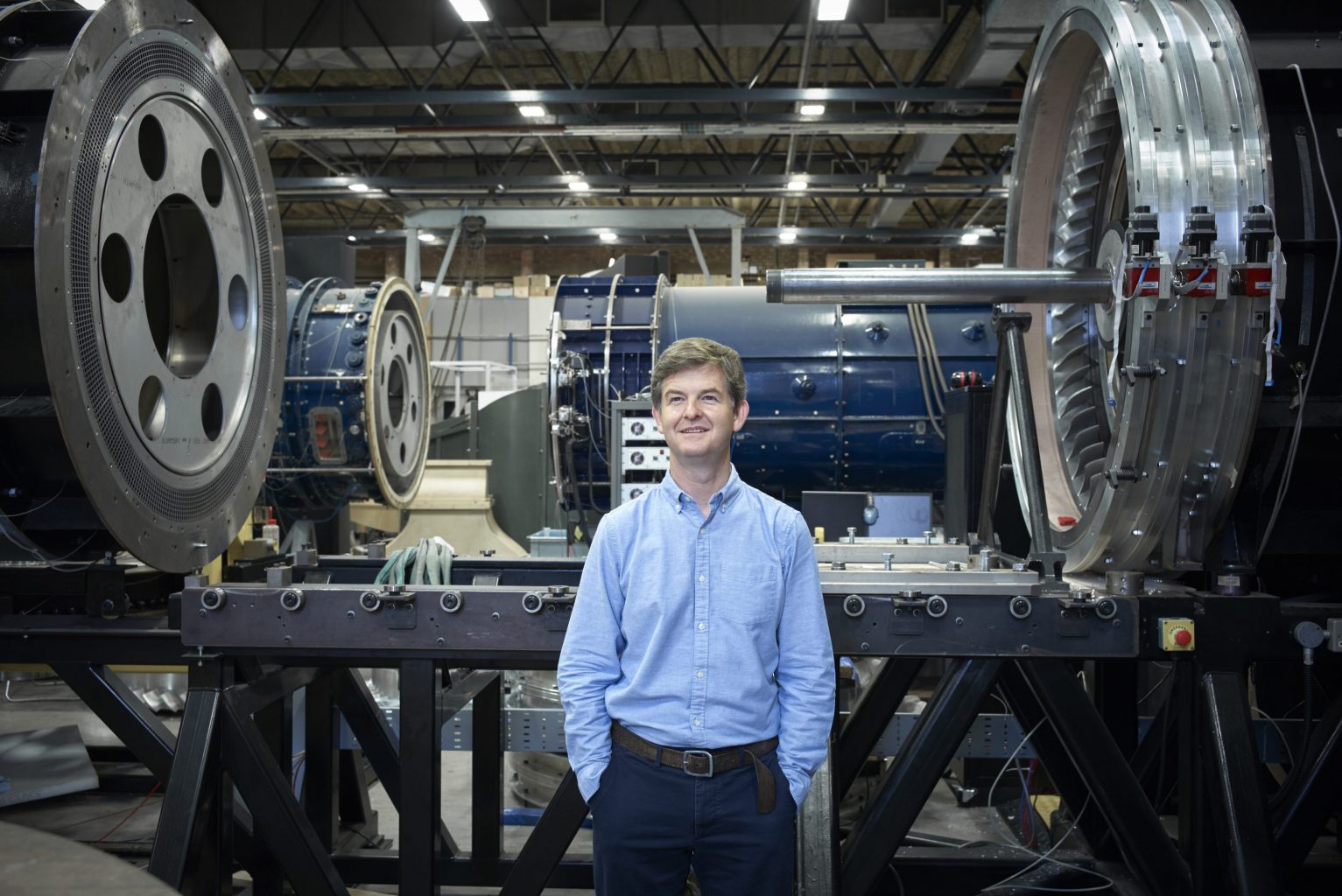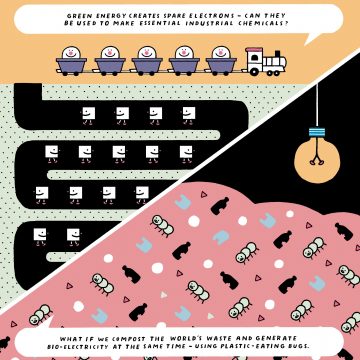Have a green flight!
A carbon-neutral economy in 50 years? Maybe. But what if we were to go faster? Professor Rob Miller says that it is time to completely rethink the schedule.
How long will it take to make zero-carbon flight a reality? Thirty years? Longer? “Climate change means that we just don’t have that timescale,” says Professor Rob Miller. “I believe that this timescale can be cut in half and that we can have net-zero-carbon flight by 2035. But this can only become a reality if we radically change the way we develop and scale technologies”.
Thirty years ago, Professor Miller could not have imagined the challenge that he and colleagues at the Whittle Laboratory would now be taking on. Back then, he was a maths-obsessed student from South Cheshire College – an FE college not particularly known for Oxbridge applications. The youthful Miller, taking a characteristically can-do approach, decided to write directly to Professor Roger Ainsworth, a distinguished engineer and lecturer at St Catherine’s, Oxford. To his delight, Ainsworth wrote back, inviting Miller to visit him.

“I remember walking around the gardens as he talked about his love of applying maths to real world problems,” says Miller, now Chair in Aerothermal Technology and Director of the Whittle Laboratory. “He told me that he’d love me to apply, so, of course, I did – and I got in.” Ainsworth’s mentorship didn’t end there: he invited the undergraduate Miller to spend a summer working with him on a project for Rolls-Royce – sparking a lifelong relationship with the company, and a lifetime’s passion.
“That summer, I thought about aerodynamic problems in ways I’d never considered before,” Miller remembers. “Supervisions with Roger were amazing because we would always start off talking about things on the syllabus, like fluid dynamics or thermodynamics, and we’d end up talking about jet engines and how fundamental principles apply to the real world. During my PhD – which Roger also supervised – I discovered that what really excited me was translating academic ideas into reality.”
Academics couldn’t do it alone, industry couldn’t do it alone, manufacturers couldn’t do it alone. It’s the combination that is so powerful.
And so he has. As well as Rolls-Royce, he’s worked with Mitsubishi Heavy Industries, Siemens and Dyson. He holds 11 patents and has experienced first-hand the excitement of seeing work that started in the Whittle Laboratory roll off the production line. Take the Rolls-Royce’s Trent 1000 engine for Boeing’s 787. While spending a summer holiday in Rolls-Royce design office, Miller looked at whether the shape of the leading edge – that is, the first 0.5mm – of each of the necessary 6,000 compressor blades could be improved. At the time, these blades were hand-finished on the production line and could not be precisely manufactured. Miller’s computer modelling showed that this could result in a 20 to 30 per cent reduction in the loss of performance – a finding that was backed up by tests in the Whittle Laboratory. The change in blade leading-edge geometry is now estimated to save $170 million of fuel burn and 540,000 tonnes of CO2 a year. “That change was only possible with everyone working together,” he says. “Academics couldn’t do it alone, industry couldn’t do it alone, manufacturers couldn’t do it alone. It’s the combination that is so powerful.”
Miller is acutely aware of the time pressures imposed by climate change. “If we’re going to keep the Earth within 1.5 degrees of premodern temperatures, we’re going to have to cut to 1980s levels of emissions by 2030 – and get to net-zero carbon by 2050,” he says. But in the aerospace industry, it can take up to 10 years for a new technology to be implemented.
Which is where the question of timeframes comes in. “A key moment for me was a conversation with a friend, Dr Tony Dickens, who was designing Formula One cars at Red Bull. Tony asked me how long it would take for a new technology to make it into a jet engine. I said between six and 10 years,” Miller recalls. “Then I asked him what he’d done that day. His team had tested 20 rear wings. They used the tests to predict the best, made it, tested it, proved it was the best, and emailed the geometry of the most promising to the racetrack. Red Bull had a manufacturing capability at the racetrack and made the component overnight to put on the car for practice the next day.”
It reduced test times from months to days – and now, to 15 minutes, using F1-style pit teams.
At that moment, says Miller, “the penny dropped”. He applied to the UK government and the Aerospace Technology Institute to set up a rapid-technology development team. Dr Tony Dickens left Red Bull and came to the Whittle Lab to run it. That was eight years ago, and since then, says Miller, practice has been transformed. Small, focused teams help break down communication barriers. Removal of top-down management and bureaucracy encourages fast, bold action. But to move quickly, these teams also need the right tools, and this has been achieved using AI and augmented design systems. Manufacturing times have been reduced by moving the manufacture process in-house and coupling it directly to the design system. What does this mean in practice? For a set of jet engine blades, production time is cut from several months to eight hours. Finally, test times have been cut by analysing each stage in the process and then cutting or changing up to 95 per cent of them. This reduced test times from months to days – and now, to 15 minutes, using F1-style pit teams.
“We undertook a formal trial with Rolls-Royce, funded by the Aerospace Technology Institute,” says Miller, “and the team cut the development time from two years to one week.” Dramatically reducing the time to develop new technologies in this way is, Miller believes, key to accelerating the path to zero carbon. Along the way, the team also discovered that there’s something special about reducing the time scale of the technology development process to around a week. “If you have a good idea on a Monday and can design, test and learn by the Friday, then innovation explodes. People lose their fear of trying new ideas and start to play,” he says.
The new Whittle will allow us to co-locate more multidisciplinary industry and academic teams to exploit the rapid-technology development process.
The main challenge now is to scale rapid-technology development to a wider range of problems and other industries. “To achieve this, we aim to build a new Whittle Laboratory and a National Centre for Propulsion and Power,” says Miller. The National Centre will have a uniquely flexible facility, developed by Dr Nick Atkins and his team, lowering the barrier of entry for industry to work in the lab. “This is important because the cost and time required for people to work in aerospace research and development is high, and this means that only large companies are able to do it,” argues Miller. “The new Whittle will allow us to co-locate more multidisciplinary industry and academic teams to exploit the rapid-technology development process.”
During the Covid-19 pandemic, the Whittle switched its rapid-technology development teams from decarbonisation to tackling the pandemic – and the Open Ventilator System Initiative was born. “We partnered with Professor Axel Zeitler and his team from Chemical Engineering, other researchers from across the University, doctors from Addenbrooke’s and from South Africa and manufacturers from across the world,” says Miller. “We then built them into rapid-technology teams, co-located in the Whittle Lab.”
The result was the development of a flexible, intensive care-grade ventilator, the first to be manufactured in Africa and at about a tenth of the cost of other available ventilators. The project was awarded the Royal Academy of Engineering President’s Medal for Pandemic Service, recognising exceptional examples of engineering. Its impact will be felt long after the pandemic: it is estimated that around 162,000 children died of pneumonia in Nigeria in 2018. “This demonstrates the power of rapid-technology development to work in other industries and sectors”, said Miller.
If we are going to rapidly decarbonise flight and power generation, we are going to have to dramatically change both the culture and the tools we use
“If you are going to accelerate the path to zero carbon, then as well as accelerating technology development, you also need to develop the policy that will accelerate its delivery, scale-up and the associated infrastructure, investment and policy,” Miller points out. Which is where the Aviation Impact Accelerator comes in – a partnership between the Whittle, the Cambridge Institute for Sustainability Leadership, Engineering, Chemical Engineering, the BP Institute, the Hopkinson Lab and the Cambridge Judge Business School. “With the new Whittle Laboratory we have designed a Challenge Space”, says Miller. “This is specifically designed to house projects such as the Aviation Impact Accelerator. It will allow large diverse teams from across the University and industry to co-locate and take on some of the biggest climate challenges”. The Challenge Space is modelled on Cambridge’s experience in the Silent Aircraft Initiative, a project set up between Cambridge University and MIT led by Dame Ann Dowling a decade ago.
It is clear Miller believes that change is not happening fast enough. “If we are going to rapidly decarbonise flight and power generation, we are going to have to dramatically change both the culture and the tools we use.” He is firm in his belief that industry and academic collaboration is essential and is the cornerstone of the Whittle Laboratory’s historic success.
“The aviation and power generation industries are crucial to the global economy, and to global culture. In my view, it is only through ambitious programmes to reach net-zero carbon, and not through partial emission cuts of 30 per cent or 40 per cent, that we will retain society’s trust, remain an investible proposition, and deliver the clean technologies that citizens and climate scientists demand and that future generations deserve.”
Read about plans for the National Centre for Propulsion and Power and Professor Miller’s work.







